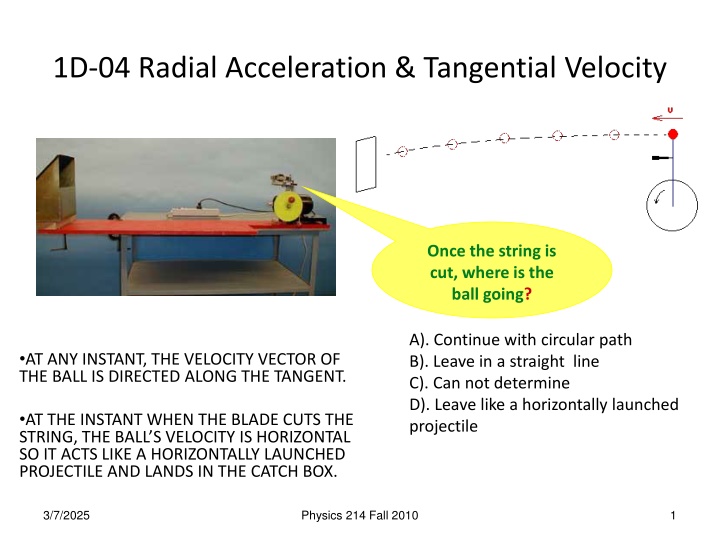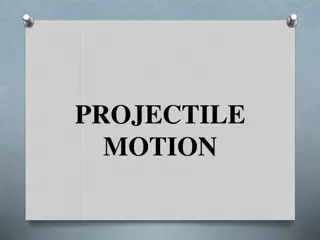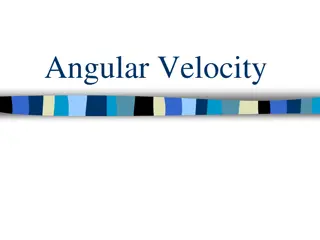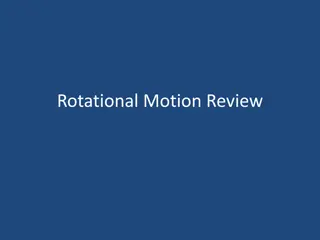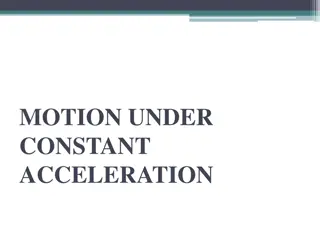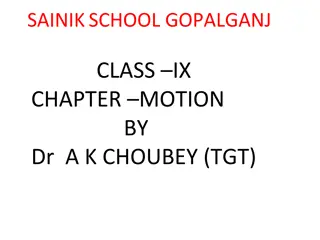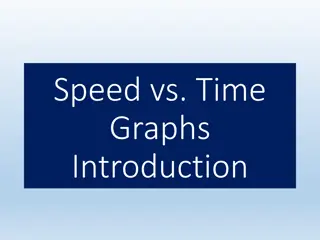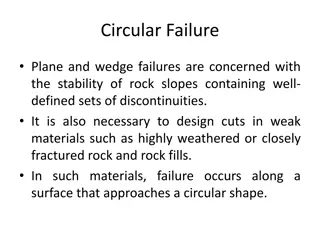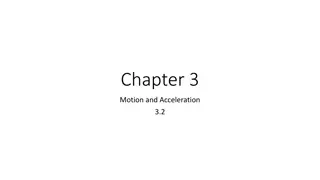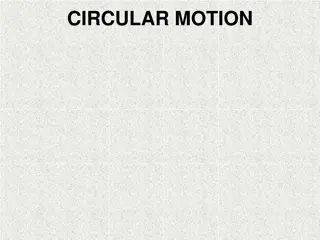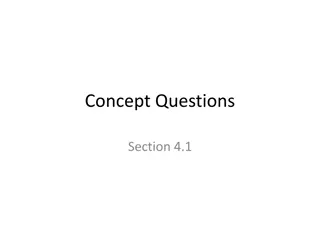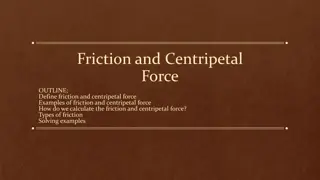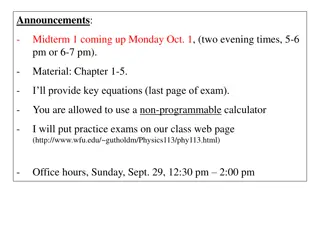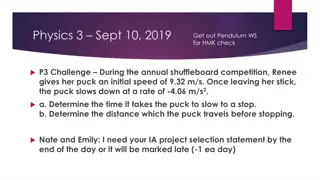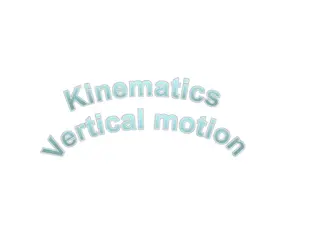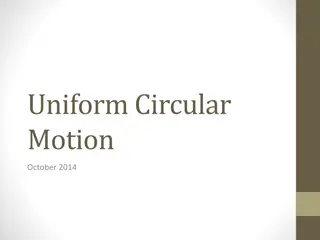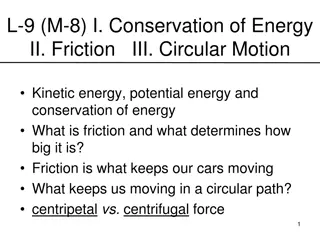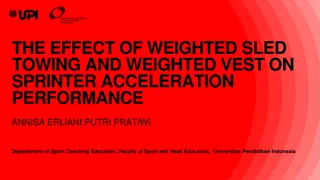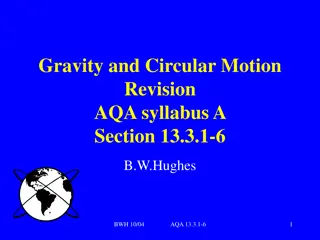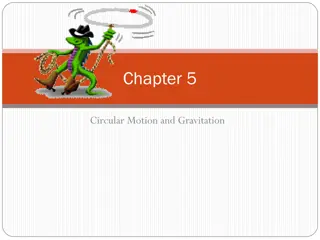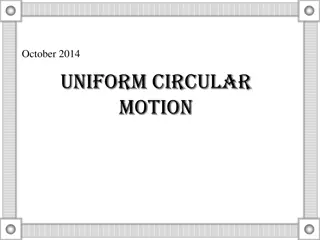Centripetal Acceleration in Circular Motion
Centripetal acceleration plays a crucial role in circular motion by indicating the rate of change in velocity and direction of an object. This acceleration is always perpendicular to the velocity, pointing towards the center of the curve. Without centripetal force, objects would move in a straight line rather than in a circular path. Explore the concepts of centripetal acceleration, forces, and their impact on objects in motion.
Download Presentation

Please find below an Image/Link to download the presentation.
The content on the website is provided AS IS for your information and personal use only. It may not be sold, licensed, or shared on other websites without obtaining consent from the author.If you encounter any issues during the download, it is possible that the publisher has removed the file from their server.
You are allowed to download the files provided on this website for personal or commercial use, subject to the condition that they are used lawfully. All files are the property of their respective owners.
The content on the website is provided AS IS for your information and personal use only. It may not be sold, licensed, or shared on other websites without obtaining consent from the author.
E N D
Presentation Transcript
1D-04 Radial Acceleration & Tangential Velocity Once the string is cut, where is the ball going? A). Continue with circular path B). Leave in a straight line C). Can not determine D). Leave like a horizontally launched projectile AT ANY INSTANT, THE VELOCITY VECTOR OF THE BALL IS DIRECTED ALONG THE TANGENT. AT THE INSTANT WHEN THE BLADE CUTS THE STRING, THE BALL S VELOCITY IS HORIZONTAL SO IT ACTS LIKE A HORIZONTALLY LAUNCHED PROJECTILE AND LANDS IN THE CATCH BOX. 3/7/2025 Physics 214 Fall 2010 1
Discussion on Triangle, Arc and Cord r When is smaller, is larger and the difference between the arc length and cord length are smaller. When is extremely small, 90o and the Length(arc) Length (cord) r When is infinitely small, 0o, 90o Length(arc) = Length (cord) r Length (arc) =Length (cord) = r ? r
Centripetal Acceleration Imagining ? is perpendicular to v V is along the tangential direction of the circle v point to the center of the circle 0 r ? = ? ? ? =??????(???) ? ac=v2 =? ? ? r ? ?=?? ? = ?
Centripetal Acceleration Centripetal acceleration is the rate of change in velocity of an object that is associated with the change in direction of the velocity. Centripetal acceleration is always perpendicular to the velocity. Centripetal acceleration always points toward the center of the curve.
Centripetal Force The centripetal force refers to any force or combination of forces that produces a centripetal acceleration. ac=v2 Fc= mac r
Centripetal Forces The centripetal force may be due to one or more individual forces, such as a normal force and/or a force due to friction. The Static force of friction is the frictional force acting when there is no motion along the surfaces. No skidding or sliding The Kinetic force of friction is the frictional force acting when there is motion along the surfaces.
On a banked circular track, assuming no friction on the surface, will the ball be able to make a circular motion with constant speed? A). Yes. B). No. friction is absolutely needed.
The normal force can be separated into a vertical component and a horizontal component The horizontal component of the normal force is the centripetal force when there s no friction in order to keep the object (car) on the circular track.
Quiz: A Car moves along a banked circular track ( =30o) and experience a normal force of 1000 N. How large is the vertical component (Nv) and horizontal component (Nh)? A). Nv = 866 N, Nh = 500N. B). Nv = 500 N, Nh = 866 N. C). Nv = 500 N, Nh = 500 N D). Nv = 866 N, Nh = 134 N. 30 o
1D-02 Conical Pendulum Vertical component of T balance the mg. Could you find the NET force? T sin( ) = mv2/R T cos( ) = mg v = sqrt( gR tan( ) ) Period of the pendulum = 2 R/v, where R = L / sin( ) = 2 sqrt( Lcos( )/g ) NET FORCE IS TOWARD THE CENTER OF THE CIRCULAR PATH \ 3/7/2025 Physics 214 Fall 2010 10
Vertical circles N v g W = mg + is always toward the center of the circle mg N = mv2/r Ferris wheel If v = 0 then N = mg At the bottom N - mg = mv2/r As v increases N becomes smaller When v2/r = g the car becomes weightless. At the top Mg N = mv2/r http://www.youtube.com/watch?v=SN77b9Dq Ebc&feature=player_detailpage 3/7/2025 Physics 214 Fall 2010 11
Ch 5 CP 2 A Ferris wheel with radius 12 m makes one complete rotation every 8 seconds. What speed do riders move at? A). 56.52 m/s B). 9.42 m/s C). 18.84 m/s D). 4.71 m/s Fcent S = d/t = 2 r/t = 2 (12m)/8s = 9.42 m/s 3/7/2025 Physics 214 Fall 2010 12
